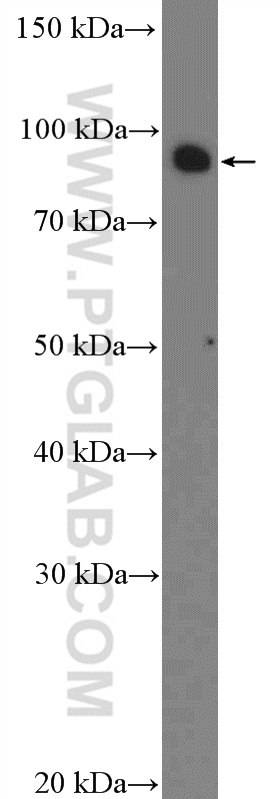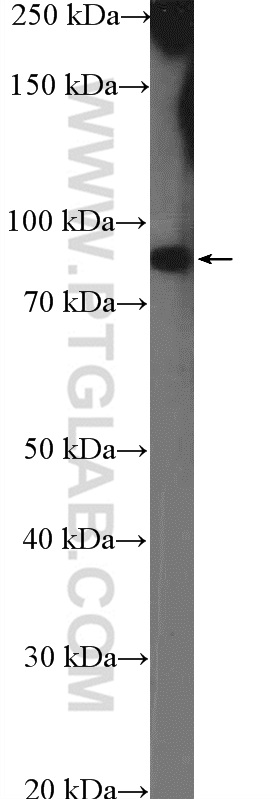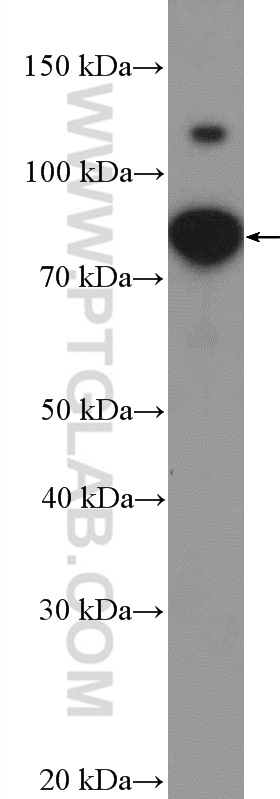验证数据展示
经过测试的应用
| Positive WB detected in | HeLa cells, Jurkat cells |
推荐稀释比
| 应用 | 推荐稀释比 |
|---|---|
| Western Blot (WB) | WB : 1:1000-1:4000 |
| It is recommended that this reagent should be titrated in each testing system to obtain optimal results. | |
| Sample-dependent, Check data in validation data gallery. | |
产品信息
26314-1-AP targets CCDC21 in WB, IF, IP, ELISA applications and shows reactivity with human samples.
| 经测试应用 | WB, ELISA Application Description |
| 文献引用应用 | WB, IF, IP |
| 经测试反应性 | human |
| 文献引用反应性 | human |
| 免疫原 |
CatNo: Ag23636 Product name: Recombinant human CCDC21 protein Source: e coli.-derived, PET30a Tag: 6*His Domain: 569-687 aa of BC064528 Sequence: MESWQKRYDSLQKIVEKQQQKMDQLRSQVQSLEQEVAQEEGTSQALREEAQRRDSALQQLRTAVKELSVQNQDLIEKNLTLQEHLRQAQPGSPPSPDTAQLALELHQELASCLQDLQAV 种属同源性预测 |
| 宿主/亚型 | Rabbit / IgG |
| 抗体类别 | Polyclonal |
| 产品类型 | Antibody |
| 全称 | coiled-coil domain containing 21 |
| 别名 | CCDC21, CEP85 |
| 观测分子量 | 85-90 kDa |
| GenBank蛋白编号 | BC064528 |
| 基因名称 | CCDC21 |
| Gene ID (NCBI) | 64793 |
| RRID | AB_2880475 |
| 偶联类型 | Unconjugated |
| 形式 | Liquid |
| 纯化方式 | Antigen affinity purification |
| UNIPROT ID | Q6P2H3 |
| 储存缓冲液 | PBS with 0.02% sodium azide and 50% glycerol, pH 7.3. |
| 储存条件 | Store at -20°C. Stable for one year after shipment. Aliquoting is unnecessary for -20oC storage. |
背景介绍
CCDC21, also named as CEP85, is a Centrosomal protein with MW 85 kDa. All the isoforms of CCDC21 can be detected by this antibody.
实验方案
| Product Specific Protocols | |
|---|---|
| WB protocol for CCDC21 antibody 26314-1-AP | Download protocol |
| Standard Protocols | |
|---|---|
| Click here to view our Standard Protocols |
发表文章
| Species | Application | Title |
|---|---|---|
iScience Cep85 Relays Plk1 Activity to Phosphorylated Nek2A for Its Timely Activation in Centrosome Disjunction. | ||
Cell Rep Human VAPome Analysis Reveals MOSPD1 and MOSPD3 as Membrane Contact Site Proteins Interacting with FFAT-Related FFNT Motifs. | ||
Acta Pharmacol Sin Comprehensive multi-omics analysis elucidates colchicine-induced toxicity mechanisms and unveils the therapeutic potential of MLN4924 and kinase inhibitors |




